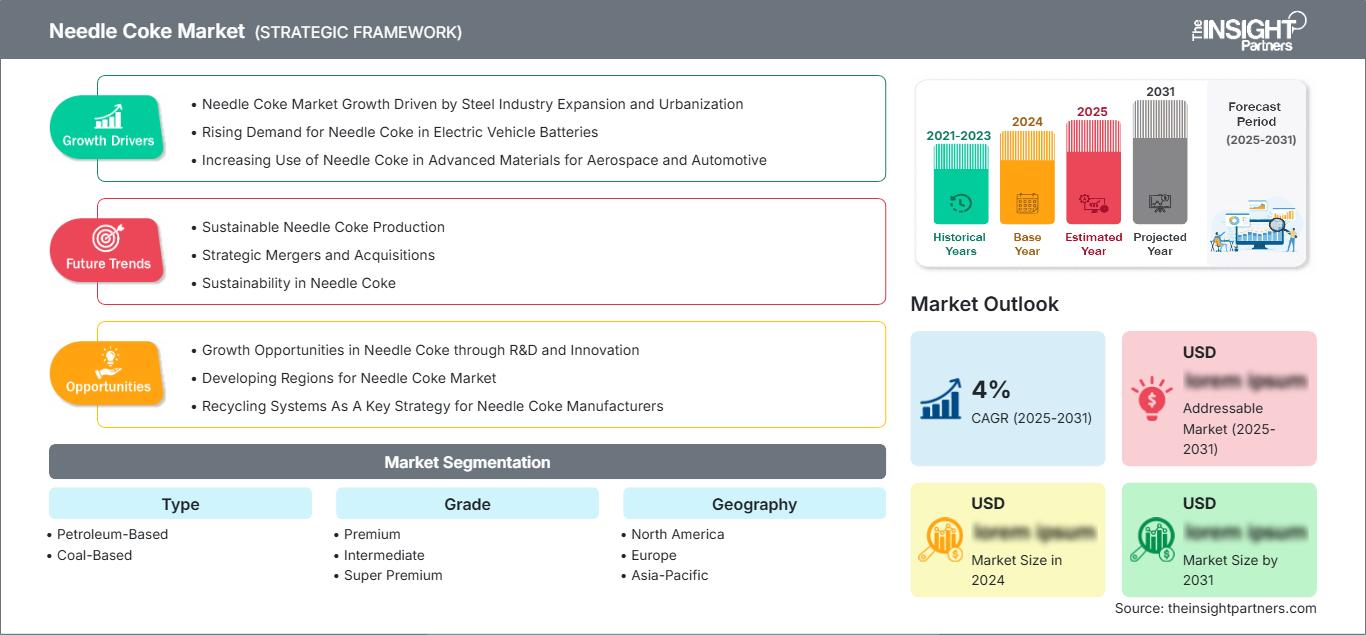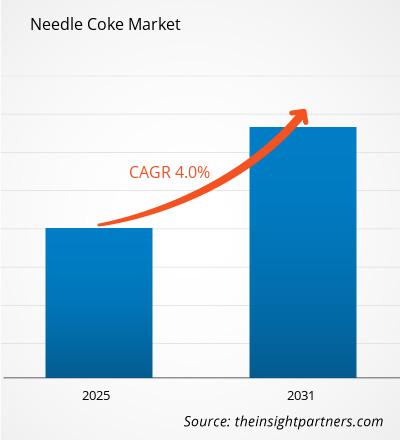Se espera que el mercado de Coca-Cola de aguja registre una CAGR del 4% entre 2025 y 2031, con un tamaño de mercado que se expandirá de US$ XX millones en 2024 a US$ XX millones en 2031.
El informe está segmentado por tipo (a base de petróleo y carbón) y grado (premium, intermedio y superpremium). Además, presenta un análisis basado en la aplicación (electrodos de grafito, baterías de iones de litio, negro de humo, entre otros). El análisis global se desglosa a nivel regional y por países principales. El alcance abarca el tamaño y las previsiones del mercado a nivel global, regional y nacional para todos los segmentos clave. El informe ofrece el valor en USD de los análisis y segmentos mencionados. El informe proporciona estadísticas clave sobre el estado del mercado de los principales actores y presenta tendencias y oportunidades.
Propósito del Informe
El informe Needle Coke Market de The Insight Partners busca describir el panorama actual y el crecimiento futuro, los principales factores impulsores, los desafíos y las oportunidades. Esto proporcionará información a diversas partes interesadas del negocio, como:
- Proveedores/fabricantes de tecnología: Para comprender la dinámica cambiante del mercado y conocer las oportunidades potenciales de crecimiento, lo que les permitirá tomar decisiones estratégicas informadas.
- Inversores: Realizar un análisis exhaustivo de tendencias respecto a la tasa de crecimiento del mercado, las proyecciones financieras del mercado y las oportunidades que existen en toda la cadena de valor.
- Órganos reguladores: Regular las políticas y las actividades policiales en el mercado con el objetivo de minimizar el abuso, preservar la confianza de los inversores y defender la integridad y estabilidad del mercado.
Segmentación del mercado de Coca-Cola de aguja
Tipo
- A base de petróleo
- A base de carbón
Calificación
- De primera calidad
- Intermedio
- Súper Premium
Obtendrá personalización en cualquier informe, sin cargo, incluidas partes de este informe o análisis a nivel de país, paquete de datos de Excel, así como también grandes ofertas y descuentos para empresas emergentes y universidades.
Mercado de Coca-Cola de aguja: Perspectivas estratégicas

-
Obtenga las principales tendencias clave del mercado de este informe.Esta muestra GRATUITA incluirá análisis de datos, desde tendencias del mercado hasta estimaciones y pronósticos.
Factores que impulsan el crecimiento del mercado de Coca-Cola con aguja
- Crecimiento del mercado del coque de aguja impulsado por la expansión de la industria siderúrgica y la urbanización: El mercado del coque de aguja se ve impulsado por la expansión de la industria siderúrgica, especialmente en los países en desarrollo. Debido a la inversión en desarrollo de infraestructura, urbanización e industrialización, se ha observado un aumento de la demanda de acero. En la fabricación de acero, el coque de aguja es fundamental para la fabricación de electrodos de grafito utilizados en hornos de arco eléctrico. Por lo tanto, la creciente demanda de acero debería impulsar el crecimiento del mercado del coque de aguja.
- Aumento de la demanda de coque de aguja en baterías de vehículos eléctricos: El creciente uso de baterías de iones de litio en vehículos eléctricos y productos electrónicos de consumo probablemente influirá en el mercado del coque de aguja. Estas baterías requieren la producción de ánodos con coque de aguja, por lo que el auge de las baterías para vehículos eléctricos también implica un aumento de la calidad del coque de aguja. Se espera que la transición a fuentes de energía renovables y el impulso a las ventas de vehículos eléctricos aumenten la capacidad de respuesta de este segmento del mercado.
- Uso creciente de coque de aguja en materiales avanzados para la industria aeroespacial y automotriz: En los últimos años, ha aumentado la demanda de materiales avanzados, incluyendo materiales a base de grafito de alta resistencia, en diversas industrias, como la aeroespacial, la automotriz y la electrónica. Es una materia prima vital para el desarrollo de compuestos de grafito de alto rendimiento que presentan excelentes propiedades de conductividad térmica y eléctrica. Por lo tanto, a medida que más industrias sigan avanzando y buscando componentes y materiales que mejoren el rendimiento y la eficiencia, aumentará la demanda de coque de aguja.
Tendencias futuras del mercado de Coca-Cola de aguja
- Producción sostenible de coque de aguja: Las investigaciones más recientes sobre tecnologías de producción de coque de aguja se centran en estrategias de producción y reducción de costes. La mayoría de los fabricantes ya han implementado nuevos procesos que optimizan el efluente de coque de aguja sin causar grandes daños al medio ambiente. Estos avances son significativos, ya que existe una mayor demanda de las diversas industrias de consumo final, y los métodos utilizados deben ser sostenibles.
- Fusiones y adquisiciones estratégicas: El mercado del coque de aguja ha experimentado un aumento de fusiones y adquisiciones estratégicas entre los gigantes de la industria. Estas alianzas buscan mejorar la oferta de productos y la cobertura del mercado, así como aprovechar las capacidades tecnológicas de cada una. Como resultado de la alianza, es probable que estas empresas conserven recursos y habilidades, mejorando así la producción y encontrando nuevos usos para el coque de aguja.
- Sostenibilidad en el coque de aguja: En el mercado del coque de aguja, la sostenibilidad se ha convertido en un problema más que en un aspecto del negocio debido a los requisitos regulatorios y a la necesidad de que los consumidores adopten productos ecológicos. Las empresas buscan una mayor sostenibilidad, por ejemplo, produciendo coque de aguja a partir de materias primas renovables o utilizando tecnologías de producción limpias. Estas tendencias no solo abordan cuestiones ambientales, sino que también favorecen los intereses comerciales de las empresas en una era en la que los productos químicos verdes se están imponiendo en la economía global.
Oportunidades de mercado de Coca-Cola de aguja
- Oportunidades de crecimiento en el coque de aguja mediante I+D e innovación: Ante el aumento de la demanda de productos de grafito de alto rendimiento, se presenta una oportunidad excepcional para los productores de coque de aguja. Al centrarse en la construcción de instalaciones de I+D, las empresas pueden desarrollar grados especializados de coque de aguja que puedan utilizarse, por ejemplo, en hornos de alta temperatura o baterías avanzadas. Estas innovaciones sin duda abrirán nuevos mercados y mejorarán sus ingresos.
- Regiones en desarrollo para el mercado de coque de aguja: Asia-Pacífico y Latinoamérica: Asia-Pacífico y Latinoamérica son regiones en desarrollo para el mercado de coque de aguja. Esta continua industrialización y urbanización se acompaña de un aumento en la demanda de acero y otros materiales de alta calidad. Las empresas pueden aprovechar esta situación, ya que es probable que la región proporcione instalaciones de construcción u otras alternativas de producción para satisfacer la creciente demanda.
- Sistemas de reciclaje como estrategia clave para los fabricantes de coque de aguja: Los fabricantes de coque de aguja pueden aprovechar la incorporación de sistemas de reciclaje en el proceso de fabricación para acceder a nuevos mercados. Las empresas pueden evitar desperdicios y reducir costos al encontrar maneras de reciclar electrodos de grafito usados y otros materiales. Este método es práctico, ya que facilita las actividades de producción y la gestión de recursos, y garantiza su respeto al medio ambiente, lo que lo convierte en una ventaja para los actores del mercado del coque de aguja.
Perspectivas regionales del mercado de Coca-Cola de aguja
Los analistas de The Insight Partners han explicado detalladamente las tendencias regionales y los factores que influyen en el mercado de Coca-Cola de Aguja durante el período de pronóstico. Esta sección también analiza los segmentos y la geografía del mercado de Coca-Cola de Aguja en América del Norte, Europa, Asia Pacífico, Oriente Medio y África, y América del Sur y Central.
Alcance del informe de mercado de Coca-Cola de aguja
| Atributo del informe | Detalles |
|---|---|
| Tamaño del mercado en 2024 | US$ XX millones |
| Tamaño del mercado en 2031 | US$ XX millones |
| CAGR global (2025-2031) | 4% |
| Datos históricos | 2021-2023 |
| Período de pronóstico | 2025-2031 |
| Segmentos cubiertos |
Por tipo
|
| Regiones y países cubiertos |
América del norte
|
| Líderes del mercado y perfiles de empresas clave |
|
Densidad de actores del mercado de Coca-Cola de aguja: comprensión de su impacto en la dinámica empresarial
El mercado de Coca-Cola Needle está creciendo rápidamente, impulsado por la creciente demanda del consumidor final debido a factores como la evolución de las preferencias del consumidor, los avances tecnológicos y un mayor conocimiento de los beneficios del producto. A medida que aumenta la demanda, las empresas amplían su oferta, innovan para satisfacer las necesidades del consumidor y aprovechan las tendencias emergentes, lo que impulsa aún más el crecimiento del mercado.

- Obtenga una descripción general de los principales actores clave del mercado de Needle Coke
Puntos clave de venta
- Cobertura integral: el informe cubre de manera integral el análisis de productos, servicios, tipos y usuarios finales del mercado Needle Coke, proporcionando un panorama holístico.
- Análisis de expertos: el informe se compila con base en el conocimiento profundo de expertos y analistas de la industria.
- Información actualizada: El informe asegura relevancia comercial debido a su cobertura de información reciente y tendencias de datos.
- Opciones de personalización: este informe se puede personalizar para satisfacer los requisitos específicos del cliente y adaptarse adecuadamente a las estrategias comerciales.
Por lo tanto, el informe de investigación sobre el mercado de Coca-Cola de aguja puede ayudar a descifrar y comprender el panorama de la industria y sus perspectivas de crecimiento. Si bien existen algunas preocupaciones válidas, las ventajas generales de este informe tienden a superar las desventajas.
- Análisis histórico (2 años), año base, pronóstico (7 años) con CAGR
- Análisis PEST y FODA
- Tamaño del mercado, valor/volumen: global, regional y nacional
- Industria y panorama competitivo
- Conjunto de datos de Excel
Informes recientes
Testimonios
Razón para comprar
- Toma de decisiones informada
- Comprensión de la dinámica del mercado
- Análisis competitivo
- Información sobre clientes
- Pronósticos del mercado
- Mitigación de riesgos
- Planificación estratégica
- Justificación de la inversión
- Identificación de mercados emergentes
- Mejora de las estrategias de marketing
- Impulso de la eficiencia operativa
- Alineación con las tendencias regulatorias






















 Obtenga una muestra gratuita para - Mercado de Coca-Cola Needle
Obtenga una muestra gratuita para - Mercado de Coca-Cola Needle